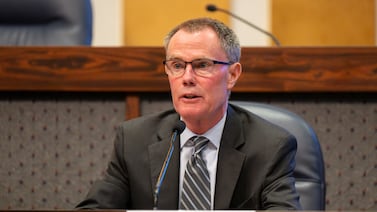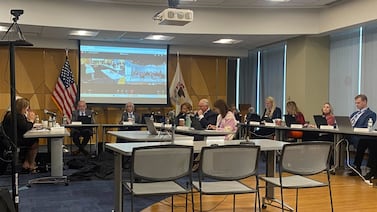Sign up for Chalkbeat Philadelphia’s free newsletter to keep up with news on the city’s public school system.
Philadelphia students’ proficiency rates in math are rising modestly but still remain low, according to an update the Philadelphia Board of Education received Thursday.
Deputy Superintendent Jermaine Dawson told board members that on the district’s most recent internal assessments — called “Star Assessments,” which are different from the state’s annual standardized tests — 22.8% of students in grades 3-8 scored at or above proficiency in math, an improvement from 18% at the beginning of this school year.
Dawson’s presentation was part of an update on the district’s Goals and Guardrails initiative, a strategic plan adopted by the school board just over four years ago that set targets for academic achievement. Board members expressed hope about the numbers but also said more must be done to help schools get on track to meet the initiative’s aims.
Students in all racial and ethnic groups improved, although persistent disparities on the Star Assessment for math state tests remained. For instance, 13% of Black students were proficient in math, compared with 14% of Hispanic, 43% of white, 50% of Asian American, and 30% of multi-racial students, according to the Star Assessments.
Board members also got an update on trends for state tests. The percentage of third through eighth graders who scored proficient or advanced in math on the Pennsylvania System of School Assessment, or PSSA, rose from 16.5% in 2021-22 to 22% last school year, said Joy Lesnick, the district’s deputy chief of research, evaluation, and academic partnership.
The Goals and Guardrails plan calls for 52% of students in grades 3-8 to be proficient on the PSSA by 2030. The state released last year’s PSSA scores in November.
This school year is the second that the district is using a math curriculum called Illustrative Math. It’s part of a $100 million curriculum overhaul the district adopted in 2022 shortly after the arrival of Superintendent Tony Watlington.
“There were some growing pains” in implementing both a new English Language Arts and math curriculum, Watlington said Thursday. But he added the district has been working closely with principals and teachers, and with their union leadership, to enhance the quality of classroom instruction.
Students in kindergarten through second grade are also improving on mastery of the appropriate curriculum benchmarks between the fall and winter of this school year, Dawson said. Such benchmarks include recognizing numbers, understanding the concept of quantity, and being able to add and subtract numbers up to 20 by the time students are in second grade.
“If we continue on this trend, that will be a contributing factor in [improving] performance of our students in third grade” and beyond, said Dawson, a former math teacher.
Board President Reginald Streater said that “while we’re still not where we want to be,” the progress is encouraging. “No one in this room is satisfied, but we are extremely pleased,” he said, especially with the collaboration among teachers, principals, administrators and employee unions.
“We are making more progress in lifting the floor, trying to raise the ceiling as well,” Watlington said. He noted that big goals — he used the example of losing weight and building muscle — aren’t reached all at once but are reached as a result of “incremental growth.”
Board member ChauWing Lam praised Dawson “for the sustained, steady progress of the past few years.” But she noted that reaching the 2030 goal for math proficiency will require a faster rate of improvement than has been occurring so far.
“I do believe strongly that we will get there,” Dawson responded, citing the district’s investment in extensive professional development for teachers and principals. He added that the district is working to provide “intensive supports” to schools that need them.
The district is also expanding high-impact tutoring from 16 tutors working in two schools to 53 working in eight schools, where they will help 447 students.
It also plans to restart Parent University, which offers classes to parents and caregivers in academics and other topics so they can help children with their school work.
“We don’t have a deficit view of our parents,” said Watlington. While it is parents’ responsibility to send their students to school on time and prepared, he said, “It is absolutely educators’ responsibility to teach kids to read, do math … we are excited to be working in partnership with our parents.”
Dale Mezzacappa is a senior writer for Chalkbeat Philadelphia, where she covers K-12 schools and early childhood education in Philadelphia. Contact Dale at dmezzacappa@chalkbeat.org.






